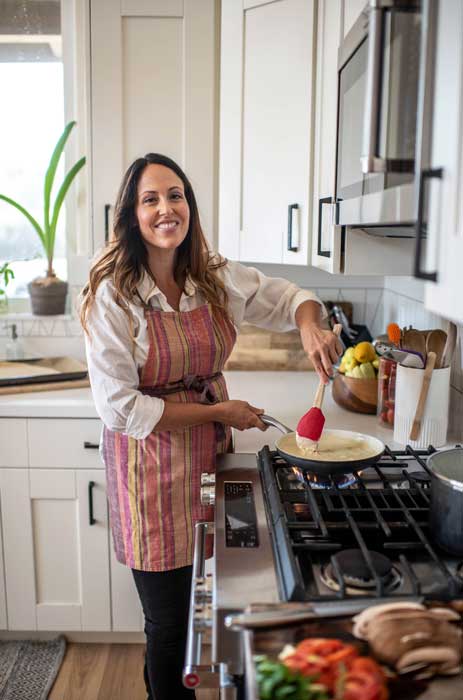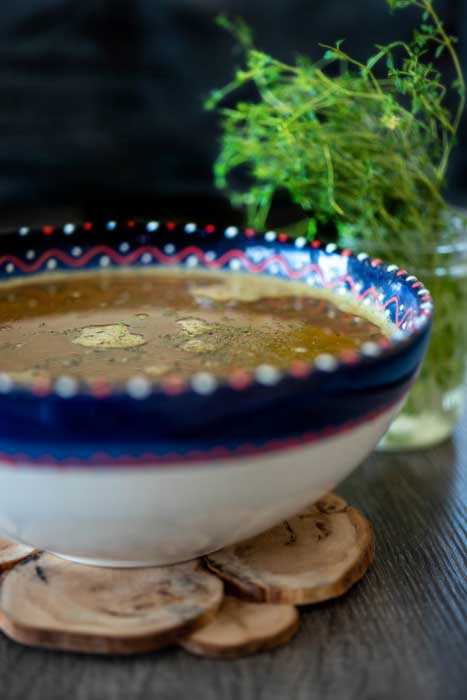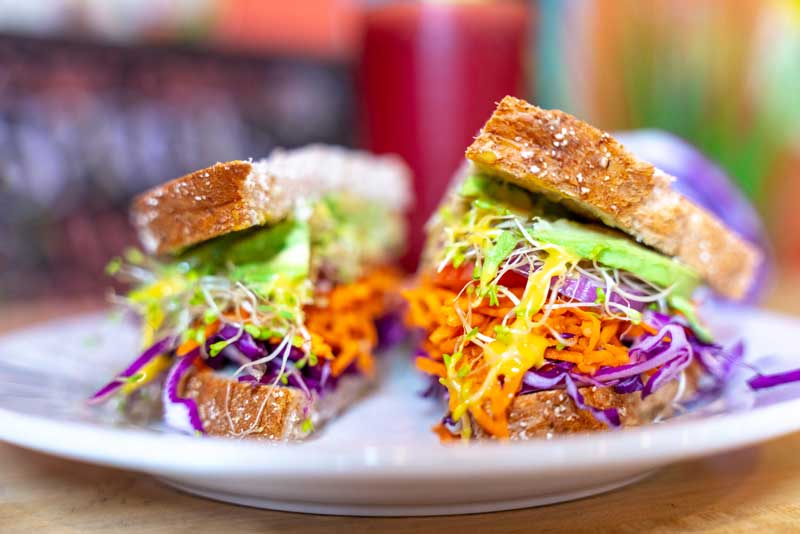More people than ever are packing their diets with plants — and you can, too.
It’s the lunch rush at Sprouts Natural Foods Café in South Lake Tahoe, and the kitchen is churning out freshly squeezed juices, tempeh burgers, and veggie-filled rice bowls. This year marks the beloved eatery’s 30th year in business — a testament to the fact that Reno-Tahoe diners’ demand for healthy, plant-heavy food is not a passing trend.
“We’ve increased items like tempeh and tofu over the years, as well as the quality of the ingredients, but we’ve really stayed true to our roots,” says Sprouts owner Tyler Cannon. “We don’t do anything overly fancy or creative, but we create good, healthy, natural food with mainly organic ingredients.”
Though there are just as many vegan and vegetarian options on the menu as those with lean proteins such as turkey and tuna, Sprouts brings in all kinds of customers, Cannon notes.
“We attract, probably because of our longevity, people who aren’t just after plant-based food. They want good food,” says Cannon, who credits this to the quality of the whole foods he uses, as well as signature flavors found throughout the menu, such as the house-made honey-mustard dressing and fresh salsa.

Cheryl and Tyler Cannon, co-owners of Sprouts Natural Foods Café in South Lake Tahoe. Photo by Wade Snider
Sprouts’ menu, brimming with colorful rice-and-bean bowls, couscous-hummus burritos, and tuna sandwiches towering with crunchy vegetables, exemplifies an increasingly popular way of eating that has become known as “the plant-based diet.” As author and food activist Michael Pollan succinctly wrote in In Defense of Food: An Eater’s Manifesto, “Eat food. Not too much. Mostly plants.”
Plant-based eating focuses on getting a majority of your food not just from fruits and vegetables, but also beans, legumes, whole grains, nuts, seeds, and plant-derived oils. While for some it can mean eschewing all meat (vegetarian) and dairy (vegan), others prefer to simply reduce their intake of animal products in favor of more plants — an approach sometimes referred to as “flexitarian.”
Food as medicine
For Karen Bain, dietitian, health and wellness coach, and diabetes care and education specialist at the University of Nevada, Reno School of Medicine, a plant-based diet is similar to the Mediterranean diet that health care professionals have been promoting for years.
“The Mediterranean eating plan has been a great way to eat, especially for those with heart disease, type 2 diabetes, and high blood pressure,” Bain explains. “It is very plant centered, though it brings lean proteins into the eating plan.”
Chicken, eggs, cheese, and yogurt also are incorporated in moderation, and red meat on occasion. In both large population studies and clinical trials, the Mediterranean diet has been shown to reduce the risk of heart disease, metabolic syndrome, diabetes, certain types of cancer, and depression. A vegetarian diet also has been proven to lower the risk of coronary heart disease, high blood pressure, and diabetes, and to increase longevity.
“Do we recommend a completely vegetarian diet? As far as dietitians, we promote healthy eating patterns, and when you look at the healthy plate visual — it could be through the Dietary Guidelines for Americans 2015-2020 or even ChooseMyPlate — it shows that you have three-quarters of a plate as an opportunity to choose plant-based, high-nutrient-quality selections,” Bain explains. “The other quarter could be lean proteins that are also plant based, such as edamame, tofu, lentils, or legumes, or it could even be fish or chicken or other low-saturated-fat protein choices.”
The three-quarters of the “healthy plate” breaks down into one-half fruits and vegetables and a quarter whole grains, such as quinoa, brown rice, or whole-grain pasta.
At UNR Med, where Bain teaches, a student-led movement has resulted in the integration of more nutrition into the curriculum, a reflection of the medical field’s continued shift to focusing on prevention, not just treatment, of disease.
“Conscientiousness of nutrition is spreading within the medical field like wildfire,” says Tasha Vazquez, a student in the UNR Med class of 2022 and a vegan, in a press release announcing the curriculum in July 2019. “More and more physicians are implementing nutritional methods of treatment for chronic and inflammatory diseases and are sharing their successes and experiences.”
Med students not only learn about the role of nutrition in chronic diseases, including dementia and cancer, but they also get hands-on, healthy-cooking experience in the kitchen.
“We are seeing a trend nationwide, not just at UNR Med,” Bain says. “The nutrition curriculum we purchased through Tulane University has been purchased by more than 70 other schools across the country, so the interest is there, and it’s only going to grow because we need to be more preventive and look at what we do now before a disease settles in.”
Growing popularity
When Gehn Shibayama moved from the Bay Area to Reno in 2014, one year after removing all meat and dairy from his diet, he found himself getting quizzical looks from waiters when he asked if a dish was vegan. Today, it’s a different story.
“The whole community has become more vegan friendly. It’s really spreading, not just in Reno, but around the world,” says Shibayama, who runs VegNV, a community of vegans, vegetarians, and other plant-based eaters in Northern Nevada. “You don’t need to become 100 percent plant based; even just increasing your plant intake can improve your health and help the environment.”
Shibayama credits his plant-based diet for giving him more energy, improving his cholesterol numbers, and helping him lose weight.
“In 2015, I hiked the 221-mile John Muir Trail in the Sierra Nevada, spending 20 days in the mountains, eating 100 percent plant-based foods. It was an amazing, life-changing experience,” he recalls. “So I kept backpacking more, and in 2018, I hiked the 2,560-mile Pacific Crest Trail from Mexico to Canada, spending six months in the wilderness, eating a 100 percent plant-based diet, of course. I finished it on my 50th birthday. In my opinion, my healthy, plant-based diet enabled me to finish the hike, from which many young people in their 20s and 30s drop out.”
Through VegNV, Shibayama fosters a community of plant lovers to provide the support he says was crucial in his transition from an “eat-anything diet” to vegan. VegNV hosts potlucks and, on its website, keeps a detailed list of restaurants that have vegan and vegetarian options or the flexibility to alter dishes. Shibayama favors Reno-based eateries Laughing Planet, Great Full Gardens, and Thali and Maya’s South Indian Cuisine at the West Street Market.
“Almost all fast-food chains are experimenting with meat alternatives, too. I hope they are not just temporary trends but stay. I haven’t had meat in seven years, but some of them are so close to meat that I can’t tell the difference,” says Shibayama (with the caveat that these processed meat alternatives aren’t necessarily healthy).
Plants… They’re what’s for dinner
Indeed, plant-based options, specifically meat alternatives designed to taste as close to the real deal as possible, now can be found everywhere from the drive-through at Burger King to the meat aisle at Whole Foods Market.
The surge in interest over plant-based meat alternatives over the last few years is due, in part, to the fact that these products are no longer strictly marketed toward vegan or vegetarian consumers, but also toward the more plant-focused flexitarian who still eats meat in moderation.
With health care officials advising consumers to limit their red meat consumption and growing awareness of the animal welfare concerns and environmental impacts stemming from factory farms, meat alternatives have exploded in popularity since the Beyond Burger became the first plant-based protein to grace the meat case in 2016.
In part fueled by the pandemic and concern over food security, sales of fresh meat alternatives increased 255 percent in the last week of March, compared to the same period in 2019, according to Nielsen, an American data firm. Sales were 158 percent year over year in the last week of February before the U.S. entered a state of emergency.
But what is actually in these new-aged mock meats? Impossible Burger gets most of its protein from soy protein concentrate, while coconut oil and sunflower oil up the fat content for juiciness. To add the meaty flavor and “bleed” to the burger, Impossible uses heme, or soy leghemoglobin, found most abundantly in animal flesh, but in this case it’s made through the fermentation of genetically engineered yeast. The product also is fortified with nutrients that a vegan or vegetarian might not otherwise get.
From jackfruit masquerading as flavorful carnitas in tacos to cauliflower getting the barbecued chicken wing treatment, plant-based eating does not have to come at the sacrifice of indulgence.
Change begins at home
“Anything you enjoy in a standard American diet can be veganized,” confirms Michele Swaczyna, a performer-turned-certified holistic nutritionist, vegan blogger, and YouTuber living in Reno.
After learning about veganism from a close friend, Swaczyna made the change basically overnight and found the lifestyle to be instrumental in keeping up her stamina while singing and dancing on stage.
“I always stuck more to the whole foods route to veganism. It was never hard to find fruits and vegetables, whole grains, nuts and seeds, and beans and legumes,” Swaczyna explains. “I think there are a whole lot more processed vegan foods out there than there have ever been, so it makes it easier for people to transition but maybe not in such a healthy way.”

Michele Swaczyna prepares cashew “cheese” for her plant-based Alfredo pizza at her Washoe Valley home. Photo by Candice Vivien
The mother of two keeps her pantry stocked with brown rice, dried beans, whole-grain pasta, canned tomato products, oats, sweet potatoes, onions, and almond flour to use with fresh veggies and plenty of spices to create vibrant, plant-based meals for her husband, newborn daughter, and three-year-old son. She shares her recipes on her website, Veganmichele.com, and to her 15,000 subscribers on YouTube.
“If you have your ‘why’ set in place — why you’re choosing to do this, whether it’s health related or for your family and children, or you want to have more energy, or it’s for the environment and animals — keeping that at the forefront of your mind is going to push you to make the effort,” Swaczyna explains.
As a certified holistic nutritionist, Swaczyna also advises clients on how to make the transition to a plant-based diet. It can be as simple as starting with plant-based breakfasts with your family, she says.
“It’s the easiest meal to switch over and not feel like you’re missing anything,” she explains. “It’s easy to throw together a smoothie or avocado toast with veggies on top or oatmeal. Then maybe you add in a few lunches a week, or a ‘meatless Monday,’ when you eat plant-based for breakfast, lunch, and dinner.”
Swaczyna recommends keeping your pantry stocked with essentials, making ample use of dried spices and fresh herbs, and looking online for inspiration from the hundreds of food bloggers sharing recipes online. Flavor powerhouses such as umami-rich miso and nutritional yeast also are great tools for keeping your meat- and dairy-free meals interesting.
“I think there’s a misconception that you just have to eat lettuce or that it won’t be flavorful. That couldn’t be further from the truth,” Swaczyna says. “You can create delicious, plant-based dishes that your whole family will love.”
Claire McArthur is a freelance writer who is just as likely to dig into a cauliflower-crusted-Margherita pizza as she is a medium-rare steak. Because, balance.
Pack in More Plants
Looking for ways to add more fruits and veggies to your diet? Try these simple tips to inspire you in the kitchen and make healthy decisions when you eat out:
- Start a Meatless Monday tradition in your house, when every meal you eat for the day is vegetarian. If you enjoy it, consider adding another day!
- Commit to making breakfast meat free and chock-full of fruits and vegetables, whether that’s oatmeal filled with berries or sautéed greens and a fried egg on toast.
- Buy vegetarian or vegan cookbooks to refer to when you’re at a loss for plant-based meal ideas. Some popular cookbooks include I Can Cook Vegan by Isa Chandra Moskowitz, Six Seasons: A New Way with Vegetables by Joshua McFadden, and Vegetable Kingdom by Bryant Terry.
- Follow veg-friendly food bloggers on social media (@Vegan_michele!) to see what they are cooking at home.
- Scope out a restaurant’s menu online ahead of time to see what plant-based entrées they have and commit to ordering a meat-free meal.
- Experiment with plant-based proteins to see what you like the most. It’s estimated that there are 400 different types of beans growing around the world — not to mention countless ways to prepare them — so don’t be afraid to try something new. There also are tofu, tempeh, and plant-based burger patties and sausages to try cooking with using new techniques.
Plant-based Alfredo Pizza
(courtesy of Michele Swaczyna, certified holistic nutritionist and vegan blogger in Reno. Serves 2 to 4)

Photo by Candice Vivien
For dough
¾ cup lukewarm water
1 teaspoon active dry yeast
2 cups all-purpose flour or whole wheat flour, plus more for kneading
¾ teaspoon salt
For Alfredo sauce
Heaping ½ cup raw cashews (soaked and drained)
1 tablespoon arrowroot starch or all-purpose flour
2 tablespoons nutritional yeast
2 cloves garlic
¼ teaspoon salt
1 cup unsweetened plant milk (Swaczyna uses cashew)
Toppings
Desired amount of vegan shredded mozzarella and Cheddar cheeses (Violife or Daiya work well)
Portobello mushroom, sliced
Tomato, sliced
Spinach, cut into ribbons
2 to 4 garlic cloves, sliced lengthwise
Crushed red chili flakes (optional)
Nutritional yeast (optional)
Preheat the oven to 450 degrees F and line a baking sheet with parchment paper.
To make the dough, pour the water into medium mixing bowl and sprinkle yeast over the water. Let stand 5 minutes until dissolved and foamy. Add flour and salt. Mix with wooden spoon and then knead with hands until a shaggy dough forms. Turn the dough onto floured work surface and knead until it forms a smooth, tacky ball, about 5 to 8 minutes. Cover dough with the upside-down bowl, and let it rest while you make the Alfredo sauce and chop the toppings (about 15 minutes).
To make Alfredo sauce, place all sauce ingredients in high-speed blender; blend on high 1 to 2 minutes, until smooth and creamy. Taste and adjust flavors if needed. Set aside.
Chop vegetables for toppings. Roll out dough on floured surface to reach desired crust size, thickness, and shape. Transfer to baking sheet. Pour sauce into a pan and cook over medium-low heat until slightly thickened, 1 to 2 minutes. Make sure to stir frequently.
Assemble pizza by putting sauce, then shredded cheese, then vegetable toppings and desired spices on top of dough. Bake 15 to 20 minutes, checking bottom of crust occasionally for your desired crispiness. Once ready, let cool a few minutes, then cut into slices and enjoy!
Comforting Split Pea Soup
(courtesy of Michele Swaczyna, certified holistic nutritionist and vegan blogger in Reno. Serves 2 to 4)

Photo by Candice Vivien
1 cup dry green split peas, rinsed and drained
7 cups vegetable broth
1 bay leaf
1 medium sweet onion, chopped
1 carrot, chopped into rounds
1 medium sweet potato, peeled and chopped
½ teaspoon thyme
½ teaspoon black pepper
1 cup water
1 tablespoon fresh dill, chopped
In a large soup pot, place split peas, vegetable broth, and bay leaf. Allow to simmer on medium heat, slightly covered, for 60 to 90 minutes. After peas are almost tender, add onion, carrot, sweet potato, thyme, pepper, and 1 cup of water. Simmer on medium to low heat for another 15 to 20 minutes until vegetables are tender. Turn off heat completely, cover, and let stand at least 10 minutes. Add fresh dill and serve.


